I won’t ever forget my ride with the Honda CB1100. It has left an indelible impression on me for a number of reasons: 1. It reminds me of my first bike, 2. It’s a special bike on its own, and 3. The circumstances in which I got to ride it were particular in themselves.
And now, it’s likely to have been the last air-cooled four-cylinder bike we could have bought new (if we didn’t).
How I got to ride it is a brief but good story. I had had a bad day at work — stressful and kind of pointless — the kind that led to me eventually quitting.
I bailed a little early (it was Friday) and went to my nearby motorcycle dealer just before closing. “Looking for something?” he asked. “Nah,” I admitted. “I just had an annoying day and wanted some motorcycle therapy on my way home.” I was happy to just look and dream — one of the bikes on display was a Kawasaki ZRX1200R, which I can never get enough of.
“I had a bad day too,” he said. “Hey, you want to take some bikes for a ride? No obligation.”
He made my day — I’ll never forget it, Moto Mike!
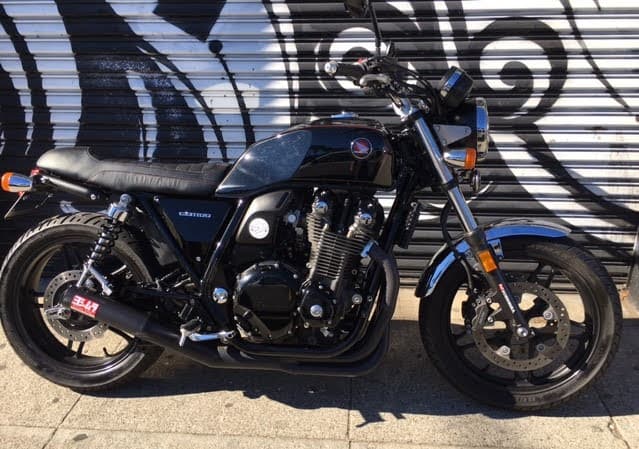
Anyway, among the bikes he had was a Honda CB1100. Just bought from an auction show, lightly modified, and cool looking as heck. I only have this low-res pic, so it’ll do.
Even though I had my eye on the always-sexy ZRX1200R, he insisted I try the Honda CB1100. “The ZRX is cooler,” he said. “But this one’s faster.”
I don’t know if that’s true — I mean, there are many definitions of “fast”. But the CB1100 was definitely fast enough.
What baffles me is that the Honda CB1100 never really garnered market traction. I get it, there are alternatives out there. But the CB1100 deserves its own little corner of the market. And I can barely find them, used. Why is that? Did they barely sell, or do people barely sell them?
But anyway, that ride satisfied a few questions I had before ever getting to throw a leg over a CB1100. These were:
- Is the Honda CB1100 actually “fast”? Or is it a leisurely cruiser like the Bonneville?
- Is the Honda CB1100 as good looking in person as it is in photos? (Spoiler… yes)
- Is the Honda CB1100 “too heavy” as the spec sheets imply?
Anyway, here’s what I found out.
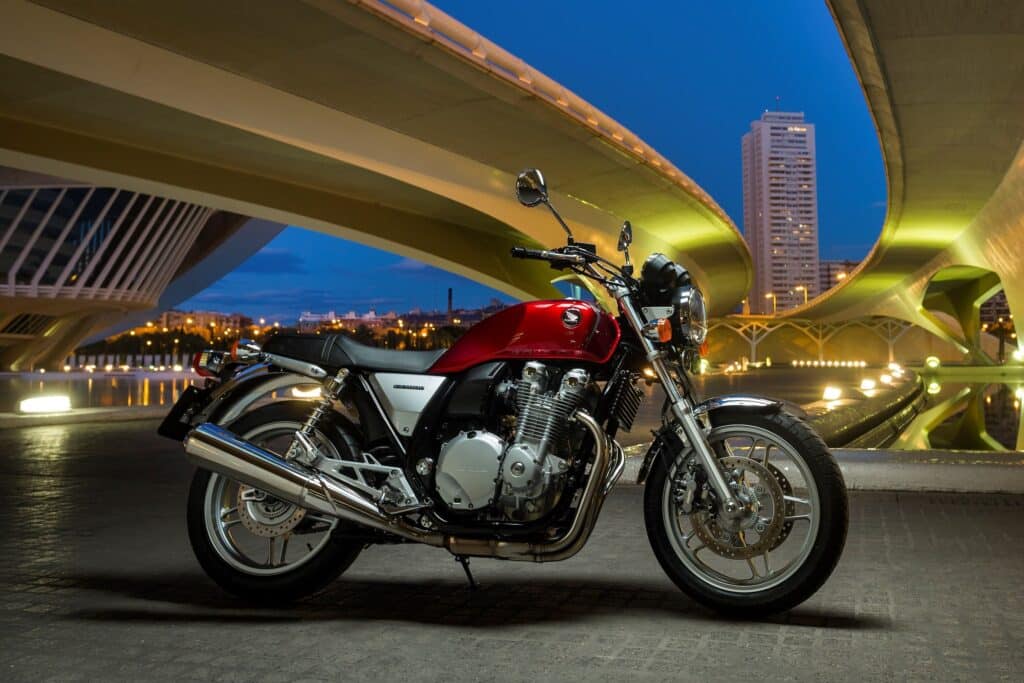
Are you obsessed with motorcycles?
Well, I am. That’s why I created this site — as an outlet. I love learning and sharing what others might find useful. If you like what you read here, and you’re a fraction as obsessed as I am, you might like to know when I’ve published more. (Check the latest for an idea of what you’ll see.)
A Brief History of Time and the Honda CB1100
If you are old enough to remember a world before the Internet (crikey! Those grey hairs are advancing), then you may remember a genre of motorcycle called the UJM — the “Universal Japanese Motorcycle”.
The UJM is a slightly derogatory (but co-opted) term to describe Japanese motorcycles of the 1980s that shared a lot of features: usually four cylinders, an upright seating position, and a general aesthetic of “standard motorcycle”. Also two wheels, and a chain drive, by the way.
But a lot of those common things shared by UJMs were good! Despite their relative homogeneity, UJMs began to dominate motorcycle sales because of their easy good looks, reliability, and performance.
My first “big” bike was one of the now classics that I sold for roughly one thirtieth of its current market value: A Honda CB900F Bol d’Or. See my article on regret and my first motorcycle.
Anyway, anecdotally, UJMs started to become less popular in the 90s. That was the era of sportbikes. Ducati started making very pretty things with single sided swingarms. Honda decided to pursue the concept of “Total Control” with the CBR900RR FireBlade, creating the “literbike” category in one fell swoop. And adventure bikes were in their embryonic stage.
Still, Japan (mostly) was producing four-cylinder standard bikes. They were gradually getting bigger in capacity and more and more powerful. Honda made the CB1000 “Big One” Super Four, with a detuned 998 cc liquid-cooled engine from the Honda CBR1000F.
Suzuki took a similar path with the first Suzuki Bandit 1200 / Suzuki GSF1200, which had an engine from the air-cooled GSX-R1100, though with a bigger bore for more CCs, and again, detuned. Suzuki kept the Bandit low-spec and low-cost, so everyone loved it and it sold like hotcakes.
See the Suzuki Bandit 1200 / 1250 / GSX1250FA buyer’s guide.
Yamaha released the XJR1200 as a knee-jerk reaction to the GSF1200, and while it’s an awesome bike, it never quite hit home with sales volume like the Bandit did. Nor did the Yamaha XJR1300, even though it lasted until 2015.
By the 2000s, the “big naked” market started to morph into the “big naked retro” market. For example, the advertising copy for the 2001 Kawasaki ZRX1200R was “You must have known your past would catch up with you sooner or later”.
These big retro bikes started to become liquid-cooled one by one. In my guide to understand liquid cooling vs air cooling, I point out that there are lots of benefits to liquid cooling — more power, more engine reliability, and wider maintenance intervals — albeit with a trade-off because you have more tubing and things to check.
See the guide to big-bore four-cylinder motorcycles here.
And as sportbikes in the 90s and then adventure bikes in the 2010s became more popular, the popularity of UJMs waned… The US never even got the Yamaha XJR1300 or Suzuki GSX1400! There was much wailing and gnashing of teeth over the affair. I still don’t really know why Australia got them and the US didn’t. It’s usually the Aussies who don’t get stuff.
At the same time, “retro”-style motorcycles made a bit of a resurgence in the 2010s.
Triumph led the charge with their “new” Bonnevilles out of the Hinkley plant, starting in 2001 with the Bonneville 800. They used the same basic platform (expanding in CCs, and changing things) for a range of bikes, including the Scrambler.
Ducati tried to follow suit with the Sport Classic (2006-2010) line, but timing and pricing was off.
As for other brands… I can’t think of another that was consciously trying to capture the hipster market. Until Honda decided to release the CB1100.
The Arrival of the Honda CB1100
Honda first announced the Honda CB1100 late 2009 at the Tokyo Motor Show for the 2010 model year.
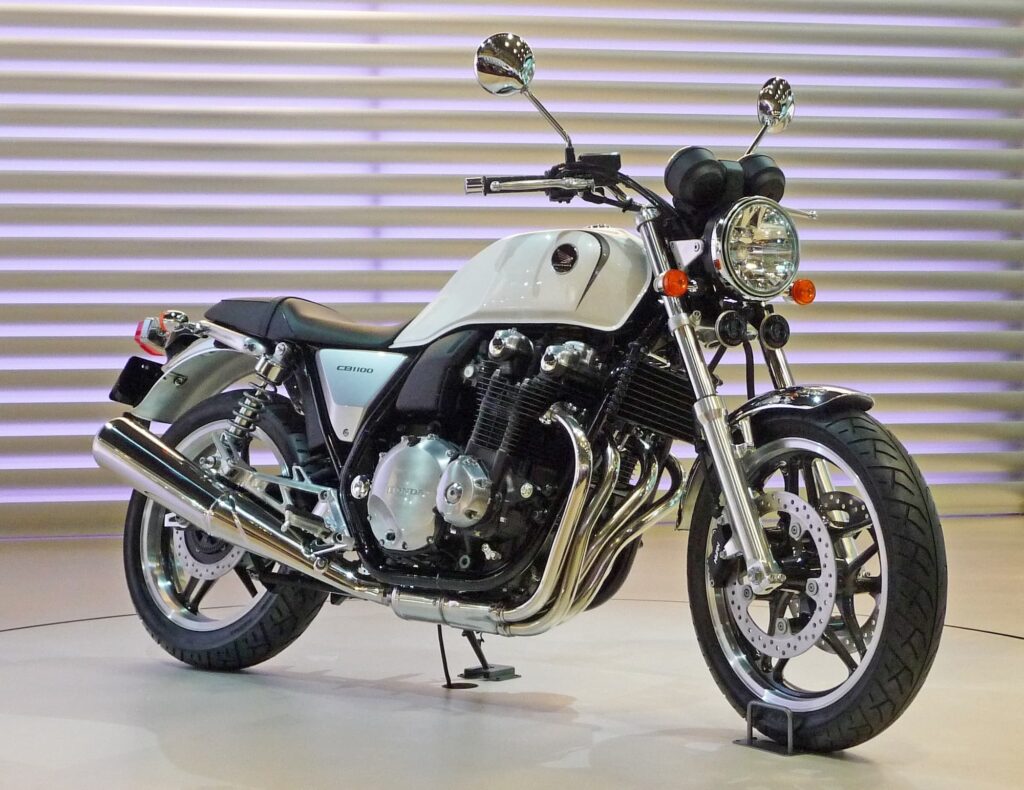
In principle, the inspiration for the Honda CB1100 was the 1975 Honda CB750 Four, a classic motorcycle from the seventies that was the first to be described as a superbike. That’s right, the CB750 was a superbike! We use that word to describe 1000-cc bikes these days, but the Honda CB750 had what was considered a massive motor at the time.
These days, people are for some reason not impressed by the CB750’s 748 ccc air-cooled motor that makes about as much power as a Bonneville T100. With similar power and weight specs to something like a Suzuki GSF650, it’d be what many Americans would call a “good beginner bike” or “decent commuter”.
But what we all acknowledge is that the CB750 Four is a very good looking motorcycle. Look at it!
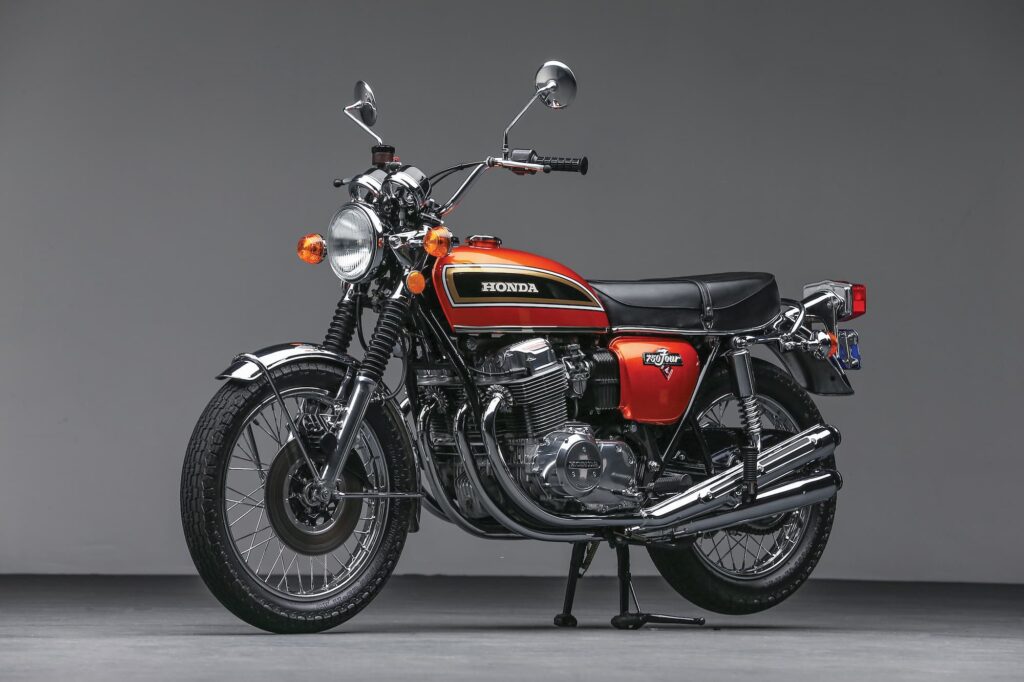
So that’s the inspiration for the original CB1100. Honda thought: Can we rebuild this, with decent specs, and meet current emissions requirements?
To do this, of course, Honda realised they’d need to up the capacity. The Honda CB1100 has more capacity and runs at a higher compression ratio, so it needs some cooling. This is in the form of oil cooling. Oil carries some heat away from the engine and dissipates it through the oil cooler, which you see up the front. The CB750 had no oil cooler.
Honda managed to squeeze an 1140cc air/oil-cooled engine into a motorcycle that’s the same size and weight as the original CB750 Four, thanks to decades of technological improvements in stronger, lighter alloys, and in frame and component design.
In 2013, Honda decided to bring the CB1100 to Europe, and in 2014 Honda made some changes and it finally made its way to the US.
Quick specs of the Honda CB1100
Common to all of the CB1100 variants is the basic engine configuration of an 1140 cc fuel-injected air/oil-cooled (there’s an oil cooler up front) inline four-cylinder engine with dual overhead cams and four valves per cylinder.
The engine has a bore and stroke of 73.5mm x 67.2mm, making it fairly long-stroke, which corresponds to its torque-forward tuning. And it runs a very mild 9.5:1 compression ratio, which means it’s quite a low-tuned engine — which usually translates to one that will last a long time.
In all generations of the CB1100, the peak power output is 66 kW (89 bhp or 90 PS) at 7500 rpm. But peak torque drops somewhat in the later 2017+ model, as shown in the table below.
Note that the 2010-2013 model wasn’t available everywhere. Australia got it in 2010, and Europe in 2013, just before the change to 6-speed.
| Part | Honda CB1100 Spec (All Models 2010-2022) |
|---|---|
| Engine | Air/oil-cooled fuel-injected 1140 cc inline four-cylinder engine, dual overhead cams, 16 valves |
| Bore / Stroke (mm) | 73.5 x 67.2 |
| Compression ratio | 9.5:1 |
| Peak power | 66 kW (89 bhp / 90 PS) @ 7500 rpm |
| Front suspension | Conventional, non-inverted fork (spec varies), all only preload adjustable |
| Rear suspension | Showa twin shocks (spec varies), all only preload adjustable |
| Weight | ~250 kg |
One reader pointed out that aside from all that, the bikes all have in common a hydraulic clutch. True, and interesting point!
Aside from that, many of the smaller aspects of the Honda CB1100 changed over the years and with the release of a couple of sub-models.
Honda CB1100 Dyno Torque Curve and Gearing
The usual story with motorcycle power specs is that the manufacturer will quote a number for power “at the crank”, and then on the dyno, you can usually measure something like power of 85-90% of that figure “at the rear wheel”.
The explanation for this is that there’s drivetrain power loss, which we mostly experience as heat that’s radiated via the radiator(s), engine casing, and exhaust. The chain and sprockets also all get hot.
Every dyno run is different, as there is a variation between equipment used, fuel, ambient temperature, and so on. But usually for a new bike, competent operator (e.g. magazine reviewers), and “normal” temperatures, there’s not a dramatic variance between dyno runs.
But I didn’t see the same difference between claimed peak power / torque and measured rear wheel power / torque. The claimed peak power for the Honda CB1100 is 66 kW (89 bhp or 90 PS) @ 7500 rpm as mentioned above. So I expected from dynos somewhere between 55-60 kW, or 70-80 hp.
Instead, here’s what dyno runs show:
| Source | Model tested | Measured rear wheel peak power | Measured rear wheel torque |
|---|---|---|---|
| Motorcycle.com | 2013 CB1100 | 81.5 hp @ 6900 rpm | 64.6 ft-lb @ 5200 rpm |
| Cycle World | 2013 CB1100 | 82.5 hp @ 7200 rpm | 64.7 ft-lb @ 5000 rpm |
| Rider Magazine | 2013 CB1100 | 85 hp @ 7300 rpm | 67 ft-lb @ 6700 rpm |
| Motorcyclist Online | 2014 CB1100 | 85.3 bhp @ 7200 rpm | 65.5 ft-lb @ 5390 rpm |
| Motorcycle.com | 2014 CB1100 | 83.5 hp @ 7200 rpm | 65.8 ft-lb @ 5800 rpm |
| Motorcycle.com | 2017 CB1100 EX | 88.3 hp @ 7500 rpm | 66.8 ft-lb @ 6300 rpm |
All of these figures actually imply that the CB1100 makes more power than Honda claims at the crank. Curious. By my estimates, around 100 bhp at the crank.
As for how that power / torque is delivered, here’s a composite of dyno runs from various runs on the internet done by big magazines. There’s not much variance between them. They all show a fairly flat torque curve, with most torque available most of the time.
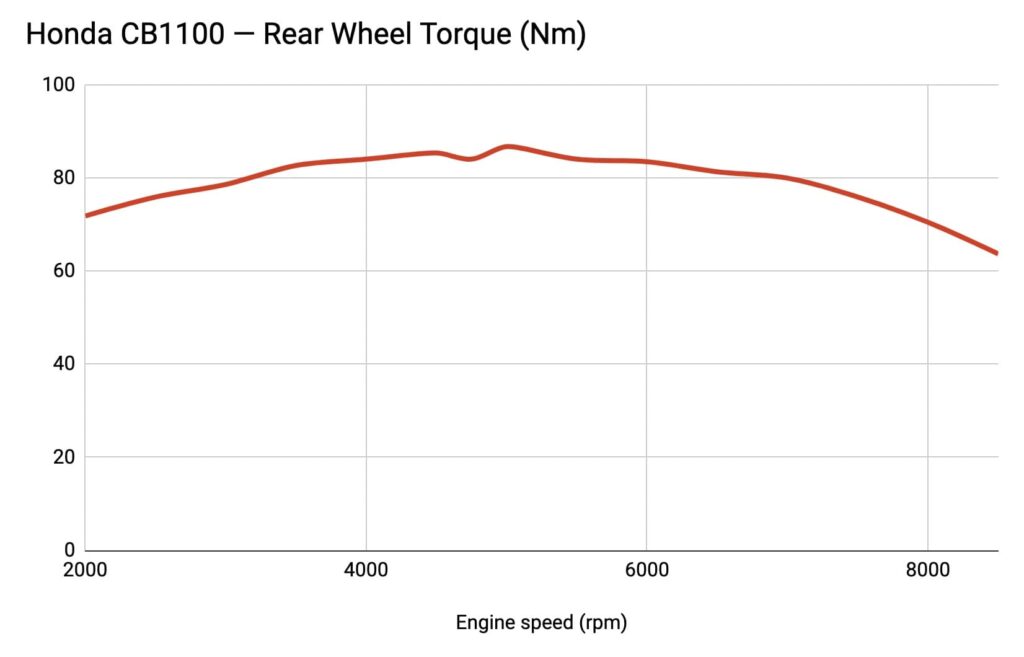
Some people talk about low-speed open/closed throttle hesitation, but if you do experience that, there are various standard ways out of it (I’d pick a remap).
The gearing also plays an important part in how “thrust” feels. I rode a model with an 18-inch wheel, which changes gearing slightly, but nonetheless — the CB1100 is torque-y enough to get the front wheel feeling light in the first couple of gears. You can definitely wheelie the CB1100 (I’ve seen enough evidence of this online), though it won’t happen by accident, and I didn’t try (not my bike).
Anyway, in a nutshell, if you’re really hammering the CB1100, you’ll normally shift gears somewhere around 80 km/h or 50 mph. I mean, that’s what I’d do if I were racing up a freeway onramp with no other cars. But usually I’d have shifted once or twice before getting there.
With normal riding, the Honda CB1100 is the kind of bike that’s happy in pretty much any gear above 40 mph / 60 km/h. I usually had it in third or fourth around town, when cruising, and didn’t worry too much about it.
CB1100 Model History — How did it change?
As mentioned above, Honda kept the engine intact over the course of the CB1100’s history. But Honda did make some subtle changes to the bike, including the gearing, instruments, lights, aesthetics, suspension, and braking. Some of this was in the different models released, too.
Below is a summary of the changes in the Honda CB1100 over the years and in different models. Bear in mind the things above that remain constant — e.g. peak quoted power remains constant, but the way torque is delivered changes.
Note on “spokes”: The cast wheels are known as five-spoke wheels in Honda’s marketing language, but they’re actually ten spokes — two parallel spokes in a five-pointed star. I’m not trying to be annoying (this time), I just noticed some magazines call them “ten-spoke”.
| Year / model | 2010-2013 | 2014-2016 | 2014-2016 DLX | 2014-2016 EX | 2017+ EX | 2017+ RS |
|---|---|---|---|---|---|---|
| Peak torque | 93 Nm @ 5000 rpm | 93 Nm @ 5000 rpm | 91 Nm @ 5000 rpm | 91 Nm @ 5000 rpm | 91 Nm @ 5500 rpm | 91 Nm @ 5500 rpm |
| Gears | 5 | 6 | 6 | 6 | 6 | 6 |
| Front suspension | 41mm telescopic fork | 41mm telescopic fork | 41mm telescopic fork | 41mm telescopic forks | 41mm Showa Dual Bending Valve | 43mm Showa Dual Bending Valve |
| Rear suspension | Showa twin shocks | Showa twin shocks | Showa twin shocks | Showa twin shocks | Showa twin shocks | Showa twin shocks, remote reservoir |
| Front brakes | 2 x 296mm floating discs, 4-piston Nissin calipers | 2 x 296mm floating discs, 4-piston Nissin calipers | 2 x 296mm floating discs, 4-piston Nissin calipers | 2 x 296mm floating discs, 4-piston Nissin calipers | 2 x 296mm floating discs, 4-piston Nissin calipers | 2 x 310 mm floating discs discs, 4-piston radial mount calipers |
| Rear exhaust | 4-2-1 single | 4-2-1 single | 4-2-2 twin | 4-2-2 twin | 4-2-2 twin | 4-2-2 twin |
| Wheels | 18 inch, 5-spoke | 18 inch, 5-spoke | 18 inch, 5-spoke | 18-inch, spoked (48-spokes) | 18-inch, stainless steel spoked (40 spokes) | 17-inch cast aluminium |
| Tires | Tubed | Tubeless | Tubeless | Tubed | Tubed | Tubeless |
| New Features | – | Updated dash | Updated dash | Updated dash | Full LED lighting Assist / slipper clutch | Full LED lighting Assist / slipper clutch |
| Tank capacity | 14.6 / 3.9 Ga | 14.6L / 3.9 Ga | 17.5L / 4.6 Ga | 17.5L / 4.6 Ga | 16.8L / 4.4 Ga | 16.8L / 4.4 Ga |
| Kerb weight | 243 kg / 536 lb | 247 kg / 545 lb | 259 kg / 571 lb | 260 kg / 573 lb | 255 kg / 562 lb | 252 kg / 556 lb |
| Reference | 2010 Press release (Japanese) | 2014 press pack | 2014 Specs | 2014 EX press pack | 2017 EX Press Pack | 2017 RS press pack |
OK, let’s start with the baseline 2010-2013 Honda CB1100. Here’s another picture of it, because that’s why many visitors are here.
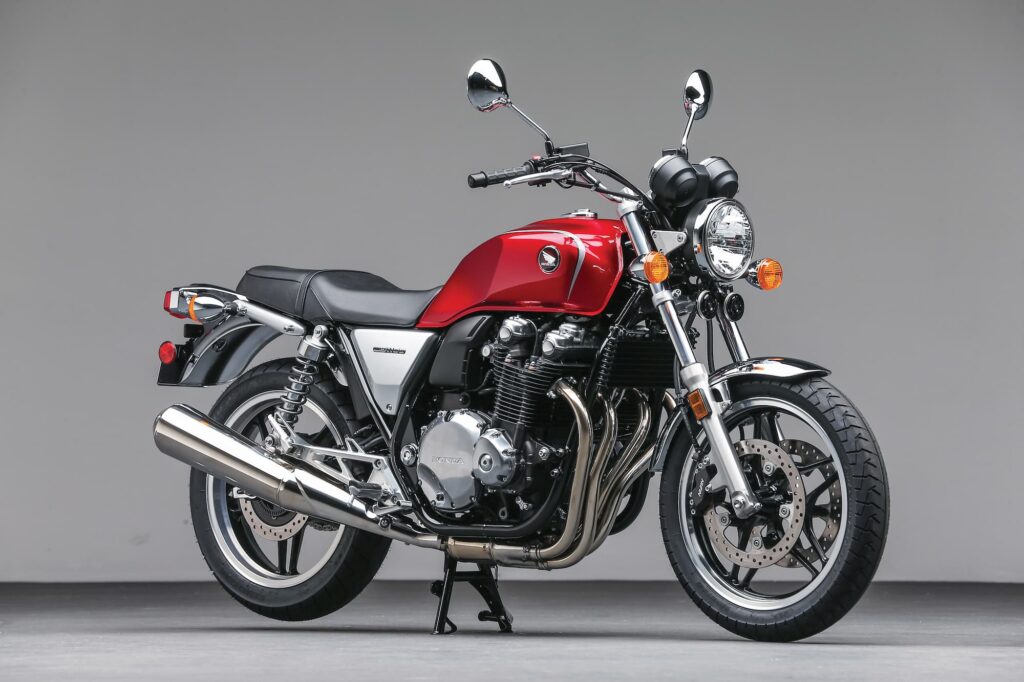
Man, that’s easy on the eye.
Visually, the first CB1100 looks nearly identical to later versions. But of course, Honda started making subtle changes.
In 2014, Honda revised the CB1100.
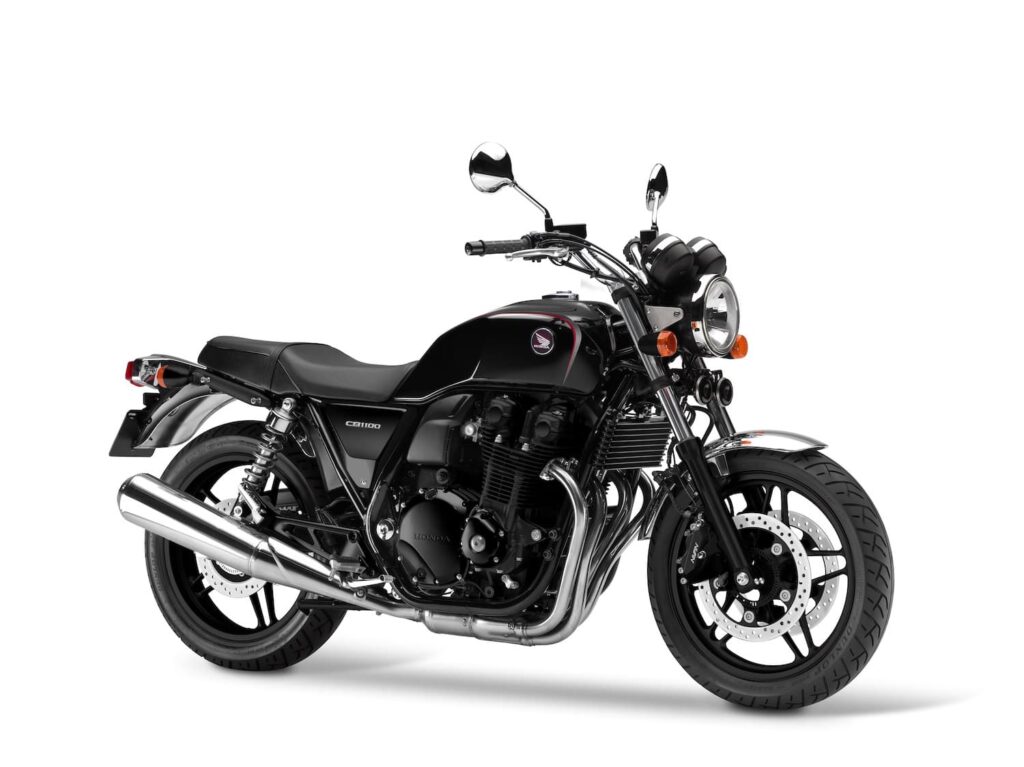
The banner update for 2014 was that the 5-speed transmission got an overdrive (the other ratios stayed the same), for better highway cruising. The 2014+ Honda CB1100 is six-speed, like most motorcycles. It’s a tiny difference, but when you’re used to six-geared bikes (the majority), or if you just have more than one motorcycle (glorious times), you find yourself constantly looking for that extra gear on the highway.
Another change Honda made for the 2014 model (all of them) is an improved center console/display. Here’s how the change looks. Ooh, a gear position indicator. So deluxe.
Speaking of “deluxe”, in 2014, Honda also released two slightly uprated versions of the CB1100, the EX (Europe) and the Deluxe / DLX (USA).
These both got a larger capacity fuel tank and twin exhausts. The twin exhausts give it a more “balanced” look, but take away the snaky exhaust pipes of the single exhaust. And they add weight! I know, it’s no lightweight, but come on, we don’t need more. In fact, on many other heavy bikes (like my beloved Busa), people super keen on reducing weight ditch the twin exhausts for a single one.
But I agree, balance does look good. If you’re not desperate to cut off 10 kg / 22 lb, then whatever. Owners of the first-generation Honda CBF1000, which also had twin exhaust pipes that changed to a single pipe for the second gen, also tend to agree that they prefer the aesthetics of the twin pipes. (See the Honda CBF1000 Buyers’ Guide.)
I would suspect the twin exhaust was done for emissions reasons (like on the 2007 Suzuki GSX-R1000, to the disappointment of many fans of the legendary K5), but there was still a base model available with a single-sided exhaust. See the below photos of all three versions.
In 2017, Honda made some more changes. Firstly from 2017 onwards Honda only made available the EX model — no “base” model” — plus a new RS model.
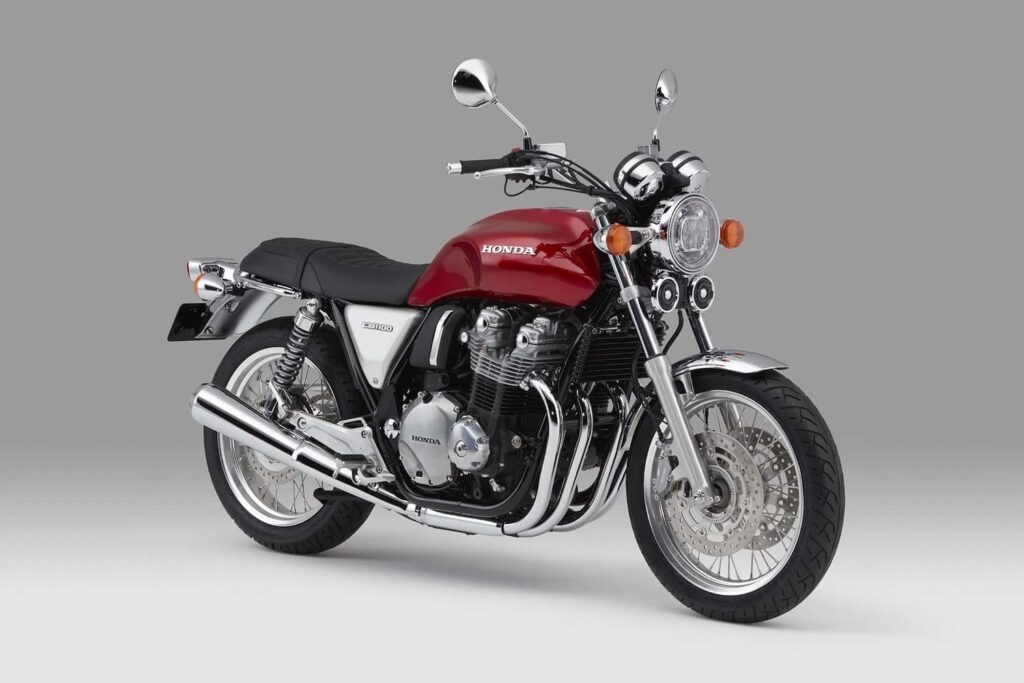
Secondly, the bike is Euro 4 compliant. It’s an unexciting technical detail, but hey they worked hard to keep this air/oil-cooled bike legal to sell and we appreciate it.
Other improvements the 2017+ CB1100 got include:
- LED front and rear lights
- Spoked wheels on the EX are stainless steel. Still 18-inch.
- Improved shocks — Showa “Dual Bending Valve” fork on both models (different fork diameters)
- Lighter twin exhausts
- Assist / slipper clutch (for easier downshifts)
- A “seamless tank”
The seamless tank looks really nice. It looks like the kind of work you only see on custom bike builds. I bet that’s a doozy to replace. In a decade or so, owners of CB1100 bikes will be wondering where they can get a second-hand seamless tank at a reasonable price.
Here’s the 2010-2016 CB1100 tank with seam (like most tanks) next to the 2017+ CB1100 model’s seamless tank:
In 2017, Honda also released a higher-spec CB1100 RS — for Europe and the UK only. It looks very “RS”, with hints of gold around the place.
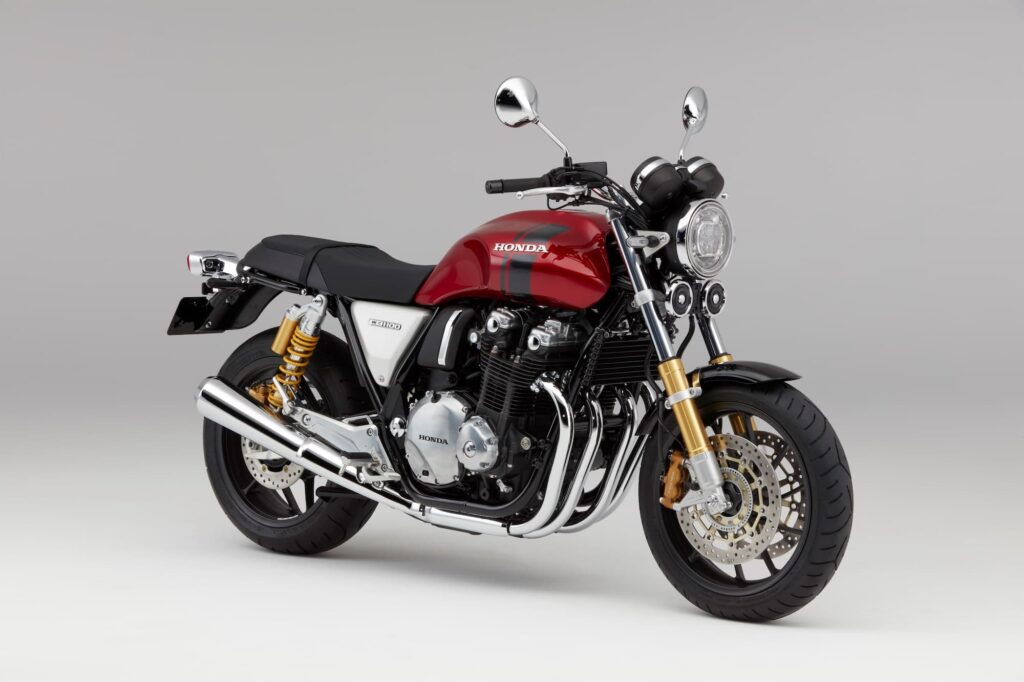
The CB1100 RS gets all the improvements of the 2017+ CB1100 model (seamless tank etc.) plus also
- 43mm Showa fork, rather than 41mm. It’s also firmer.
- Showa remote reservoir rear shocks
- 17-inch cast aluminium wheels, rather than 18-inch spoked ones
- Radial mount Tokico (vs axial mount Nissin) calipers on bigger 310 mm discs (vs 296 mm on the EX and all past models)
- Lower, more aggressive riding position (7mm forward handlebar) … maybe just a consequence of the different tire diameter
- More aggressive rake/trail (26 degrees/99mm on the RS vs 27 degrees/114mm on the EX
The engine in the RS is exactly the same. It’s not slow, but it won’t set your pants on fire, especially not pulling around this heavy a bike. If you’re looking for a fast bike, the CB1100 is probably not what you’re looking for. Maybe you want a Honda CB1000R — see the alternatives section below!
After 2017, Honda kept the CB1100 the same, just releasing more editions, until releasing a final edition for 2022.
Riding the Honda CB1100
So it’s a heavy, moderately powered, low-spec bike with a four-cylinder engine, which according to some are boring. Is that it? Should we write off the Honda CB1100, damning it because of a spec sheet?
This would be a tragedy because the CB1100 is a lot more than it seems on paper.
Needless to say, the experience of riding the Honda CB1100 starts with what I call “the approach”.
I talk about this elsewhere, but I’m in the camp of wanting to ride bikes that look nice. There are some who say you can’t see a bike while you’re riding it, and of course it’s true. (You do see the instrument cluster, which is why I also think that’s an underappreciated part of aesthetics… But that’s another topic!)
But there are many times the aesthetic experience impacts our joy. Think of a beautiful house or hotel. Driving along a tree-lined driveway, opening up to a clearing, and then seeing a magnificent building sets you up for a positive experience. Once you enter the building you can’t see it, and just hope that the experience inside matches the approach.
So the first time I saw a gleaming Honda CB1100, its snaking front exhaust headers and old-school twin gauges beckoning to me, I was hooked. At a risk of being vague, it just looked so motorcycle! The rest was up to the CB. Was the experience going to match the look? I couldn’t wait to find out.
The CB1100 I rode had some modifications done to it. It had an aftermarket exhaust and I believe a tune. I’m not sure what else. But the drivetrain and engine were original.
Firing up the Honda CB1100 is like any four cylinder Honda. It has no complaints as it starts after the briefest of button pushes and settles into a purring idle, classic Honda. Every manufacturer does four cylinder bikes differently. Honda’s four-cylinder engines have a little purr, never quite sounding at rest. All the ones I’ve ridden or owned have been like this.
A question many have about the CB1100 is: Is it too heavy? Well, it depends.
- If you’re a beginner and don’t consider yourself very big and strong, it may be too heavy.
- If you have a steep driveway and will be pushing it around a lot to get it into a parking spot, it may be too heavy.
- And if you do a lot of slow speed navigating through standstill traffic… It’s not too heavy, but a lighter bike will make your life easier.
But if you’re an experienced rider and are happy with the performance limitations that around 40 extra kilos / 100 extra pounds (over other standards) give you, then the CB1100 isn’t too heavy.
Once you’ve pulled away, like with many heavy Hondas (cough Gold Wing cough), the weight vanishes.
The next thing I started paying attention to is the instrument cluster. It’s a beauty! Particularly the 2014+ version.
Honda does some of my favourite instrument clusters. I’ve liked them on so many bikes.
The one on the CB1100 is of the general “mid-2010s” generation, which means clear dials and an LCD with a soft blue backlight at night. It’s comforting and I feel at home on it.
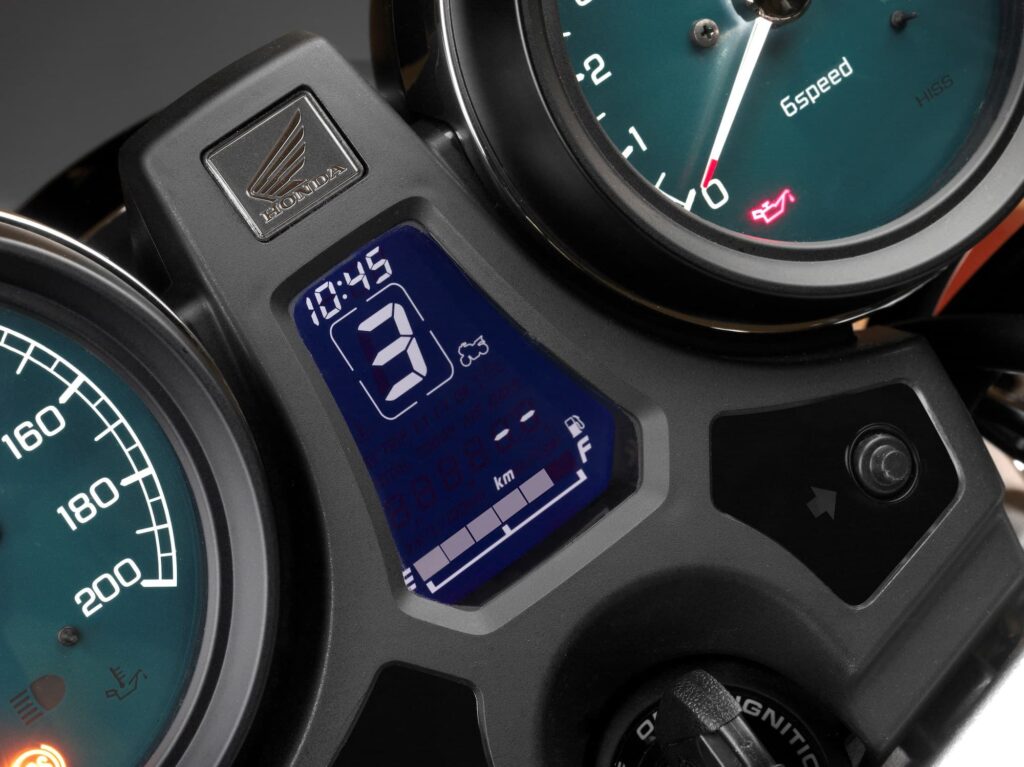
Oh, and the 2014+ models come with a gear position indicator. This one goes up to six. The previous models only had five gears, but Honda put on a gear position indicator to show just how many gears the 2014+ CB has.
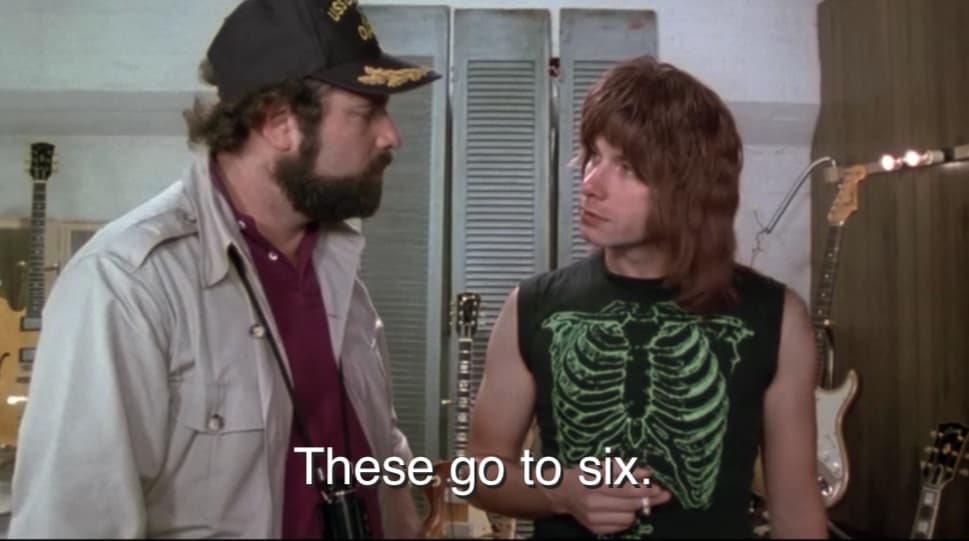
On to riding the CB1100. What’s it like?
If you’re used to riding 4-cylinder bikes, the first thing you might think is that an 8500 rpm rev ceiling (the redline) is pretty low.
The Honda CB1100 is tuned for mid-range torque, not for high-end power. The engine drops in torque around 6500 rpm before its 8500 ceiling. If you’re riding it hard, then 7000 rpm feels like a natural shifting point.
But riding the CB1100 hard is not something you’d intuitively want to do. It’s not what I wanted to do, anyway. I let on the throttle modestly, compared to most sport bikes I ride, and shifted around 5-6000 rpm like a regular human.
In that sense, it’s a lot like short-shifting a sportbike — without paying the penalty of limited low-down torque. Because the CB1100 has plenty of it!
It’s also pretty rewarding riding the CB1100 at low RPMs. I don’t know how some manufacturers do it with just some bikes, but I really like the sound of the CB1100’s engine. I mean, I like it more than I like most four-cylinder engines. Maybe it’s the air/oil cooling, maybe it’s the lack of fairings (letting me hear a bit of engine noise), or maybe it’s just a confluence of factors including the camshaft timing and exhaust choices. Whatever it is, the CB1100 isn’t “boring” — it’s got a bit of fire to it.
Alternatives to the Honda CB1100
So you’re in the market for a Honda CB1100 but want to know what else is out there in terms of modern retro bikes.
Well, it’s a fairly broad market. Bikes like the Kawasaki Z900RS, Yamaha XSR900, and Honda CB1000R are retro-esque bikes, even if they have modern liquid-cooled engines, more competent suspension and brakes, more of a focus on weight reduction, and more advanced ride aids (at least traction control).
So to limit it somewhat, let’s think of modern air-cooled standard bikes. With one exception — the Honda CB1000R, for the simple reason that the new buyer would have seen it in the showroom next to it. I certainly did, and it made a huge impact on my own preferences, so I’m including this as the outlier alternative that just shares a brand name and general aesthetic.
None of the direct competitors to the Honda CB1100 have an air-cooled inline four-cylinder engine. They’re all twins! So it’s very likely that if you want an air-cooled four, then the CB1100 will be your last chance ever.
Here’s a summary table of alternatives to the Honda CB1100.
| Spec | Honda CB1100 | BMW R nineT | Ducati Scrambler 1100 | Kawasaki W800 | Honda CB1000R (2019+) |
|---|---|---|---|---|---|
| Engine style | Inline four, air/oil-cooled | Boxer twin, air/oil-cooled | L-twin (90-degree), air/oil-cooled | Parallel twin, air/oil-cooled | Inline four, liquid-cooled |
| Style (s) of motorcycle | Standard | Standard, Scrambler, Cafe Racer (2017-2019) | Standard, Scrambler, Cafe Racer-esque | Standard, Cafe Racer | “Neo” Sport standard |
| Engine capacity (cc) | 1140 | 1170 | 1079 | 773 | 998 |
| Peak power (kW / bhp / PS | 66 kW (89 bhp / 90 PS) @ 7500 rpm | 81 kW / 109 bhp / 110 PS @ 8500 rpm | 63 kW / 84 bhp @ 7500 rpm | 35 kW / 47 bhp / 48 PS @6500 rpm | 107 kW / 143 bhp / 145 PS at 10500 rpm |
| Final drive | Chain | Shaft | Chain | Chain | Chain |
| Wet weight | ~250 kg (~550 lb) depending on model | 219 kg (483 lb): Pure, 2021 | 206 kg / 454 lb | 222 kg (491 lb) | 213 kg / 470 lb |
| Suspension | Showa conventional forks and rear shocks, both preload-adjustable | Most models: Non-adjustable conventional fork, preload adjustable monoshock | Marzocchi 45mm fork, fully adjustable. KYB rear shock, preload/rebound-adjustable | 41mm fork, dual shocks with adjustable preload | Showa SFF-BP USD, fully adjustable fork, HMAS damper with rebound and damping adjustment |
| Ride aids | ABS (optional/standard) | ABS, TC 2021+: Cornering ABS & TC, cruise | Cornering ABS & TC, ride modes | ABS | ABS, TC, Ride modes |
BMW R nineT
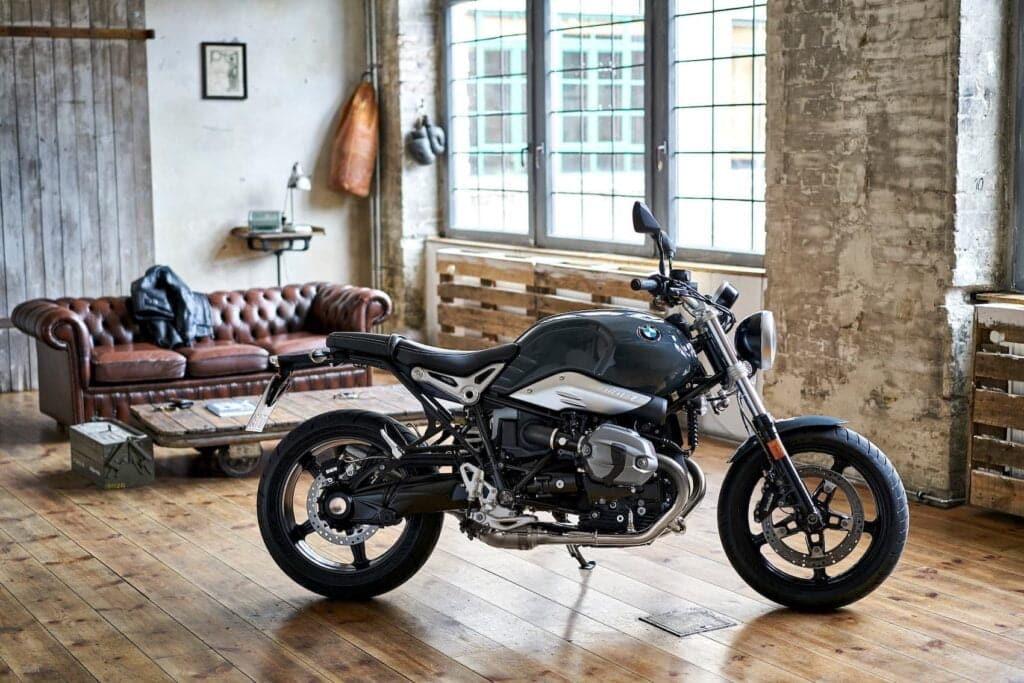
The first alternative to the Honda CB1100 is a BMW R nineT. (Spoiler: I ride one of these and love it.) Pictured above is the cheaper but still great Pure.
The R nineT is a kind of similar concept of bike — a roadster based on an air/oil-cooled engine. It’s retro-styled and calls to mind a lot of the modern R-bike airhead roadsters of the 70s or 80s. Though the R nineT isn’t based on an R 90 — the “nineT” is, according to BMW marketing copy, BMW Motorrad celebrating its 90th birthday by giving a present to itself. And to us!
The R nineT bikes (all of them, whether base model, Pure, Scrambler, Urban G/S, or Racer, and of any year) are based on an 1170 cc air/oil-cooled boxer twin that we last saw in the early-mid 2010s in the premium BMWs. Those premium bikes (like the RT, GS, etc.) all graduated to water-cooled and eventually ShiftCam VVT engines, but the R nineT kept the modern (it does have four valves per cylinder after all), but now relatively old-school design.
The engine is pretty spritely, and even though it doesn’t rev past 8500 rpm, it makes a healthy 81 kW / 110 PS / 109 bhp at 7500 rpm (give or take one or two, depending on the emissions spec you get).
It pairs this with a shaft drive, single sided swingarm, classic good looks, and really good handling, in part because of its relatively low weight (they all weigh around 210-215 kg or 465-475 lbs, a lot lighter than the CB1100).
The R nineT comes in a number of flavours, from the top-spec one with adjustable suspension and twin gauges, down to the Pure with a non-adjustable conventional fork and a single gauge. See our BMW R nineT Buyers Guide for more.
You’d pick the R nineT if you like boxers, shaft drives, generally higher-spec (particularly the base model R nineT)/higher-tech bikes (particularly 2021+), or just the BMW brand. But you’d also spend a lot more.
Ducati Scrambler 1100
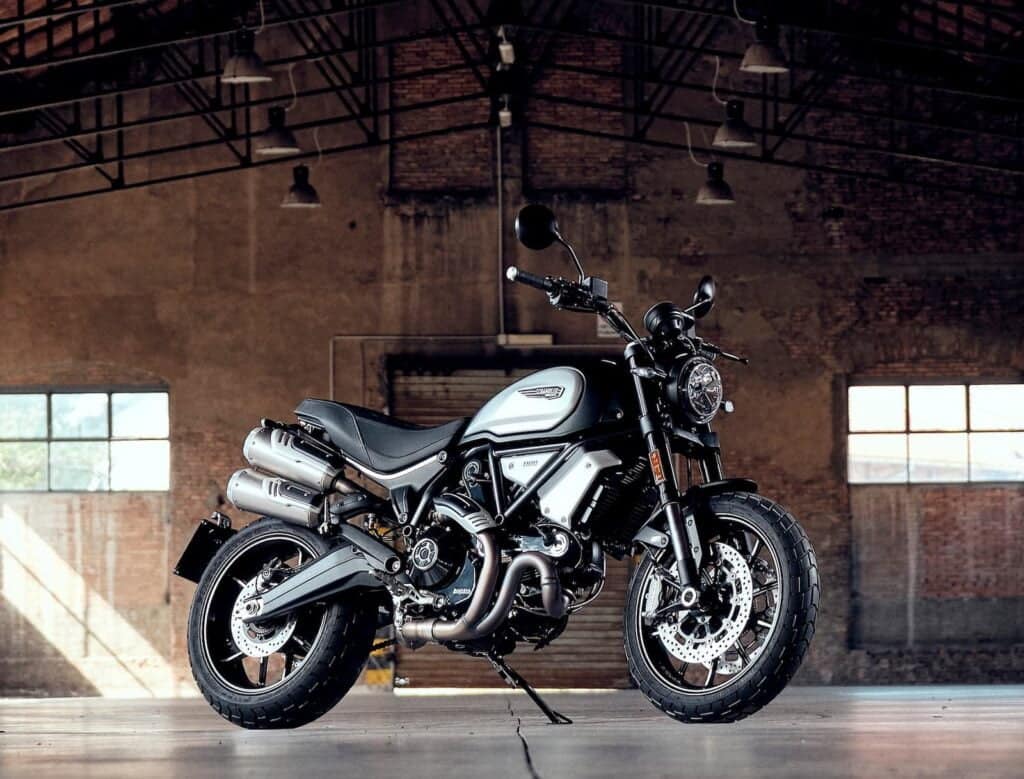
The second alternative to the Honda CB1100 is the Ducati Scrambler 1100.
Ducati has been making Scramblers since the mid 2010s, but the 1100 model is newer — in fact, so new that it came around the time that the CB1100 was retired from most western markets. No matter, it’s still an alternative!
Like the CB1100, the Scrambler 1100 is based on an air/oil-cooled motor, an L-twin we originally saw in Ducati bikes like the Ducati Monster 1100 and the original Ducati Hypermotard.
But unlike the inline four of the CB1100, air/oil-cooled V-twins aren’t quite a thing of the past yet. There are a number of them around, like in the Harley-Davidson, Indian, and Moto Guzzi ranges. There are even some from Japan, like the Yamaha Bolt. Though the Scrambler may be your last chance to ride a Ducati air/oil-cooled twin. Most of the range is now liquid-cooled.
The Scrambler 1100’s motor is a 1079 cc L-twin with two valves per cylinder that makes a peak of 63 kW (86 hp) at 7500 rpm — very similar spec to the CB1100.
But the Scrambler is much lighter, weighing only 206 kg / 454 lb, and has much higher-spec suspension — all models have fully adjustable forks and mostly adjustable rear shocks, with the top-spec ones having Öhlins units. So this feels more like a performance bike.
One thing to note is that the Scrambler isn’t really built for off-road work. Despite its name, it’s a road-going bike, just like the CB1100.
If you want a much livelier ride, prefer a V (ok, “L”, Ducati) twin, or just like Ducatis, then the Ducati Scrambler 1100 is for you.
See the full Ducati Scrambler 1100 buyer’s guide.
Kawasaki W800
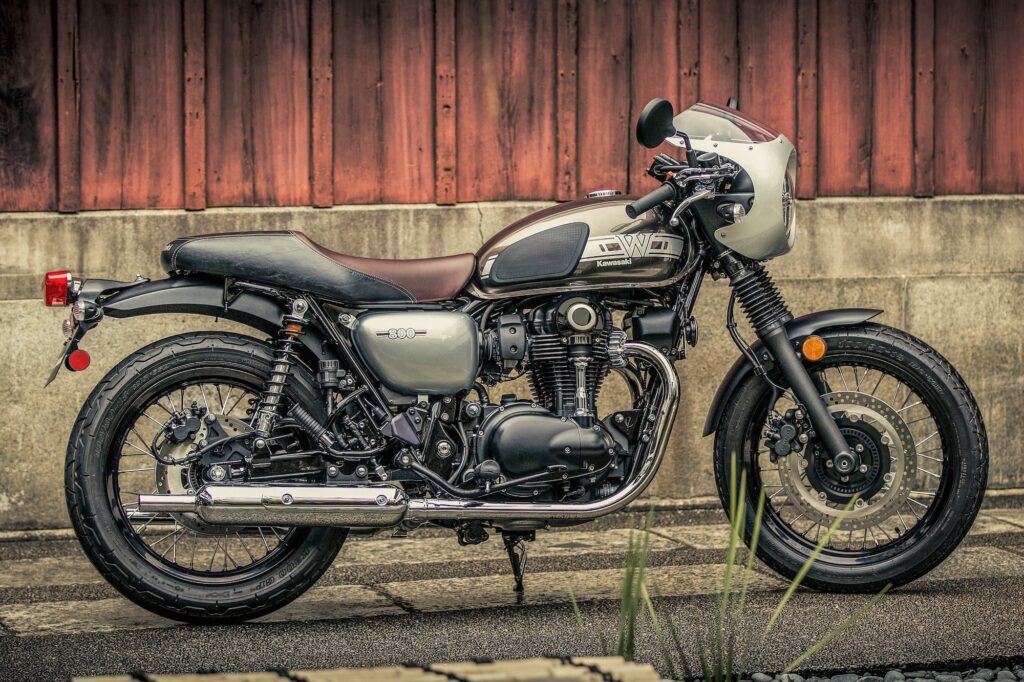
Lastly, the Kawasaki W800 is also an alternative to the Honda CB1100.
There are very few air/oil-cooled standard bikes that Japanese bikes make. In fact, the W800 is the last one in production, given the CB1100 is no longer available in most markets. Yamaha makes the Bolt, but that’s a mid-capacity cruiser. And Suzuki doesn’t have anything similar right now.
So the Kawasaki W800 it is. It comes in two guises — café or standard. They’re both pretty comfortable, and I think the standard makes more sense, given it doesn’t make a ton of power.
The 773 cc parallel twin makes peak torque of 62 Nm (46 lb-ft) at 4800 rpm, and peak power of a very gentle 35 kW (47 bhp) at 6000 rpm, making it A2 compliant in Europe / the UK, but not LAMS-compliant in most of Australia / NZ.
The rest of the bike is similarly low-spec. There’s a five-speed transmission, a non-adjustable fork and a preload-adjustable pair of rear shocks, and at the front there’s a single 320mm brake disc with a 2-piston Tokico caliper to pull up the W800’s not-inconsiderable 222 kg (491 lb), as measured by Cycle World.
But it does have ABS, and it’s standard in some markets.
If you want an even simpler bike than the CB1100, and would be happy with (or prefer) the burble of a twin, then the W800 is for you.
Honda CB1000R 2018+
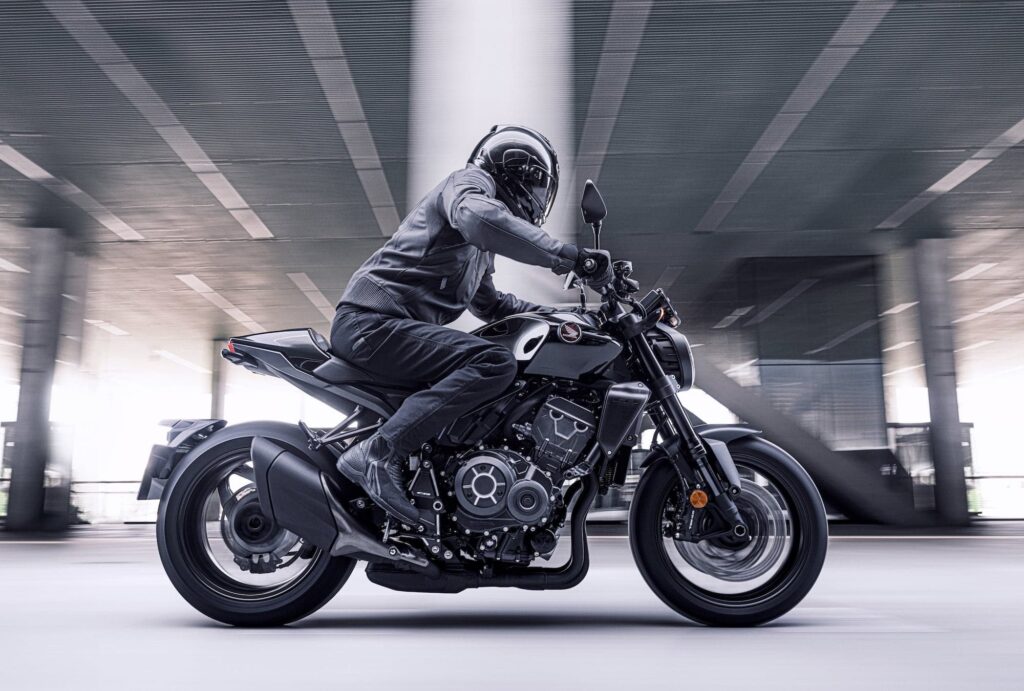
Finally, there’s the “Neo Sports Café” re-release of the Honda CB1000R.
The Honda CB1000R was already a good (if under-appreciated) bike before its redesign, but the 2018+ modern/retro version is a real looker.
It’s designed to have some classic elements, like the round front headlight, but also is unabashedly a modern sport motorcycle. The 998 cc engine puts out what was a once superbike-like level of power, 107 kW (143 bhp / 145 PS) at 10500 rpm. After all, the engine is based on the block from an older (2006) CBR1000RR Fireblade.
And all that power goes through a really nice-looking exposed rear wheel (thanks to the single-sided swingarm), and the bike is considerably lighter than the CB1100 — about 15%.
The CB1000R is stacked with high-spec equipment, from a fully adjustable inverted fork at the front (and a mostly-adjustable rear shock), radial-mounted calipers, and ride aids including ABS, traction control, and power modes.
The CB1000R has some tough competition among its direct peers, and has been squeezed out of some markets by the super-popular Yamaha MT-09, among others. But that’s not what we’re talking about here — we’re comparing it just to the CB1100.
Basically, the CB1000R is what you’d get if you want a Honda standard and you’re after performance.
Something else to bear in mind is that thanks to a) the optimisation of the CB1100 for low-end torque and b) the fact that the CB1000R has a higher-revving engine, the air/oil-cooled CB1100 doesn’t feel that much slower. If you give each bike the beans, up to 7000 rpm you can have a barrel of fun on either bike, more than enough pull for most humans, and enough to wheelie if you’re not careful.
So if you really want to feel fast between 7-11000 rpm, the R is for you. Otherwise, the CB1100 just might be enough.
See the full Honda CB1000R history and buyer’s guide.
What’s next for the Honda CB1100?
In 2022, Honda released its final edition CB1100. Final means that’s the end of the line — no more orders are being taken.
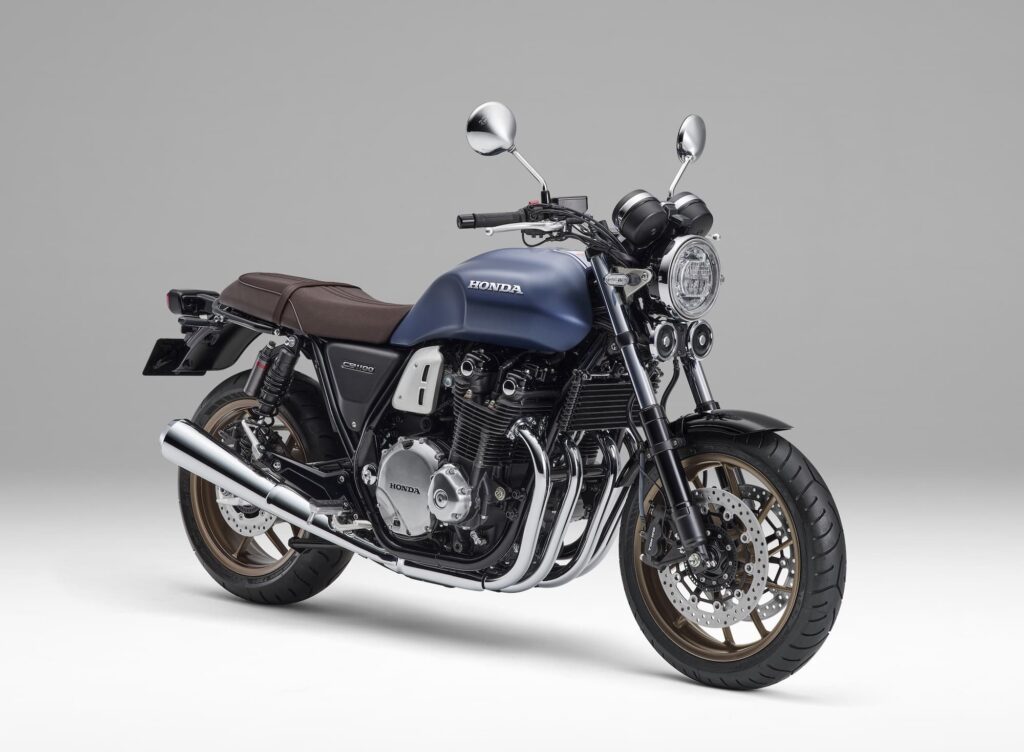
Even this final edition was only offered in Japan and maybe a few other places in small quantities.
There are so few air/oil-cooled bikes available to buy that it’s quite likely that the CB1100 was the last air/oil-cooled four cylinder bike we’ll ever see. At some point we’ll say the same about liquid-cooled four-cylinder bikes, which are also becoming less popular. And at some point, we’ll say the same about gasoline-powered bikes altogether.
Part of why I even thought about the CB1100 was when I realised that 20 years after their demise, the Honda CBX1000 is now very expensive and hard to find. The experience of riding an inline six is now available to only a select few. The same will be true of an air-cooled four at some point.
This means that if you’re really after a Honda CB1100 and come across one, don’t hesitate too long. Prices are quite low now — I see quite a few advertised for $5-7000 in the US. But in a few years, they’ll be rising again.
Of course, if you really just want a four, and don’t care too much about the air-cooled aspect — there’s always the Honda CB1000R!

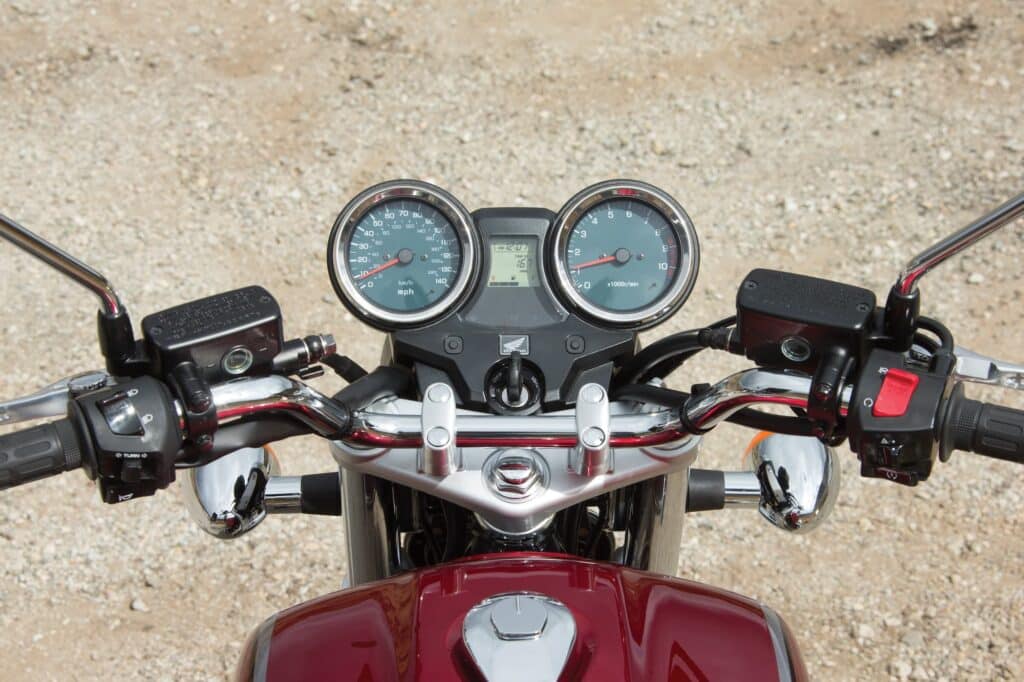
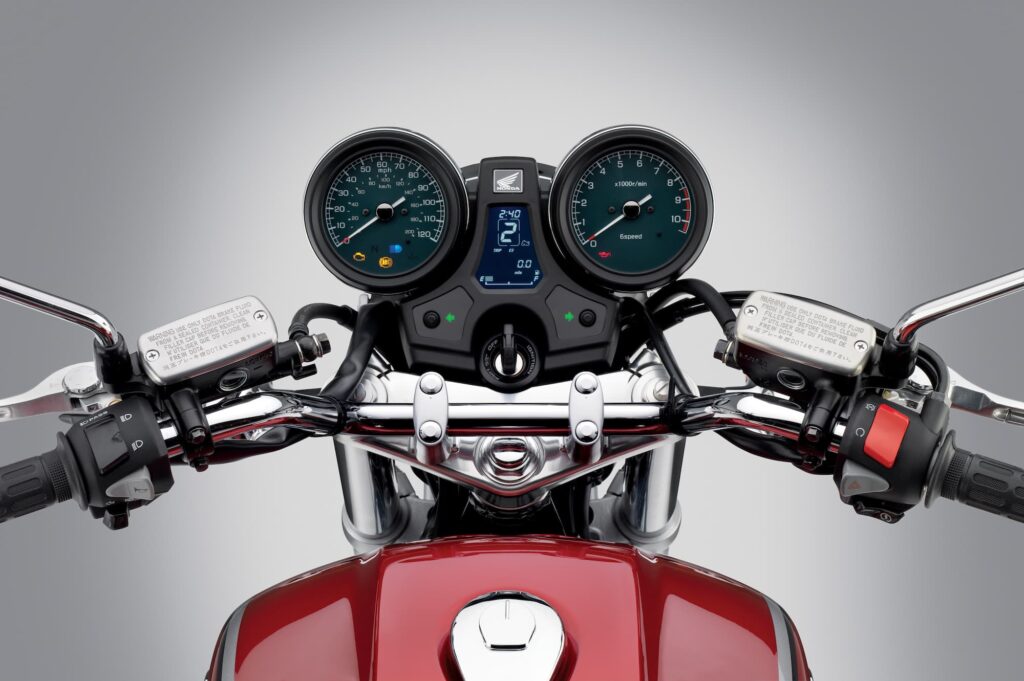
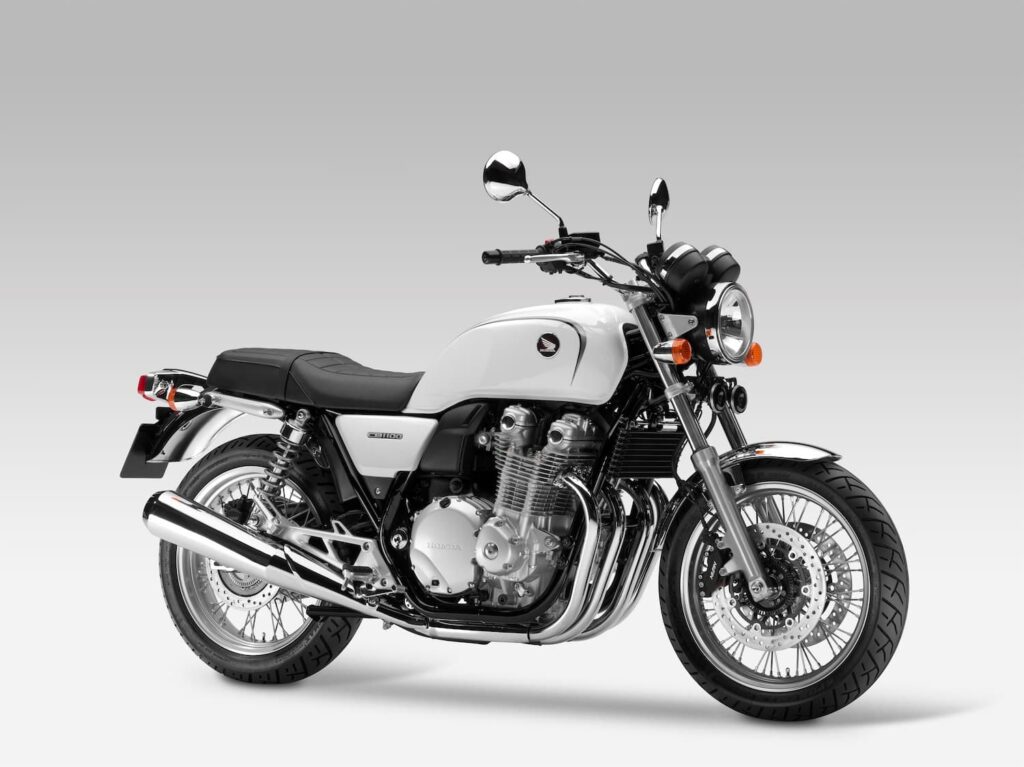
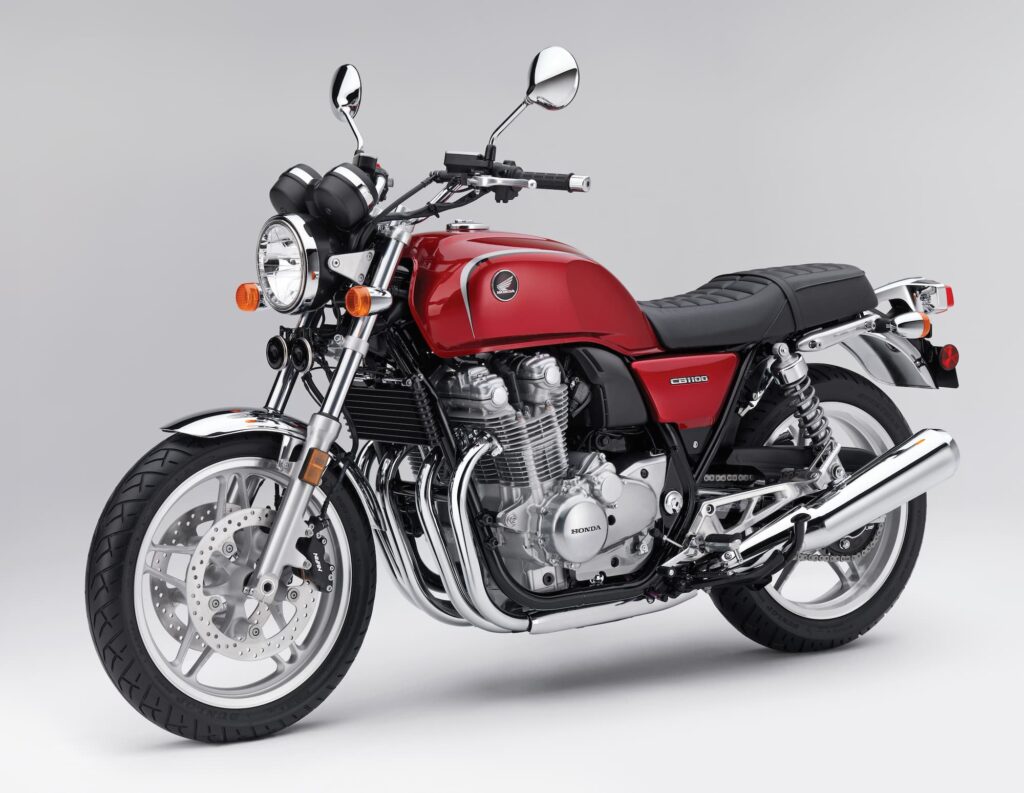
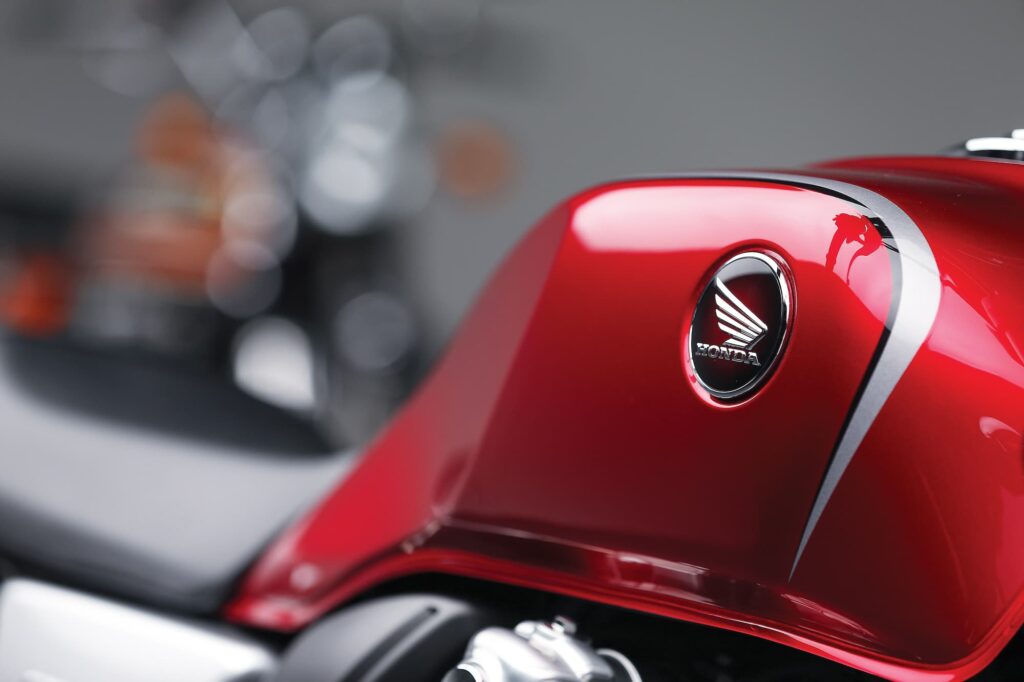
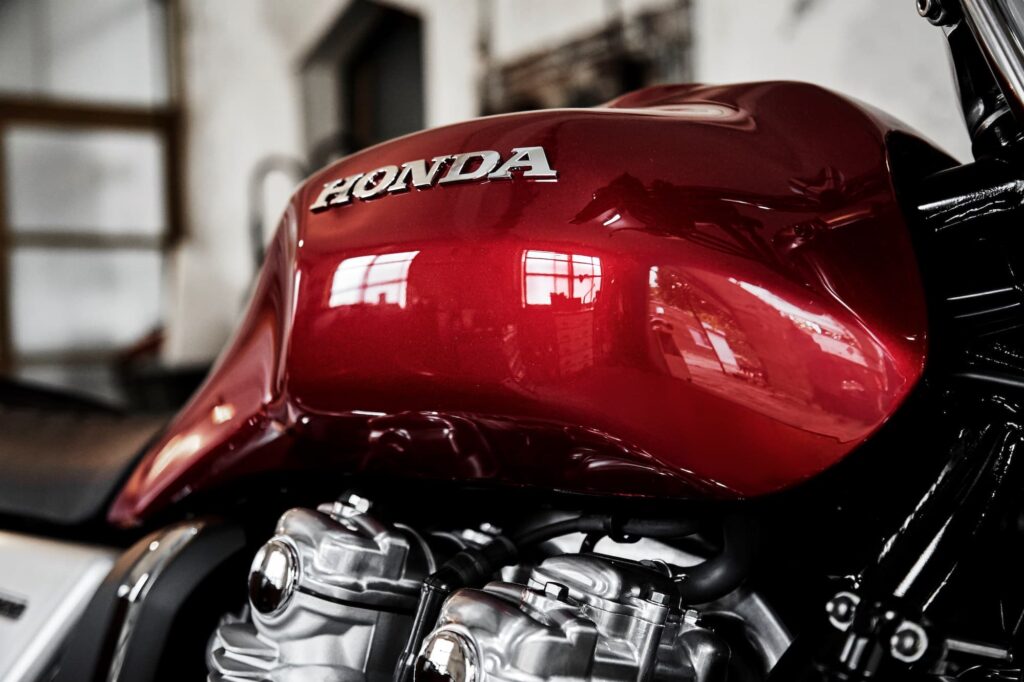
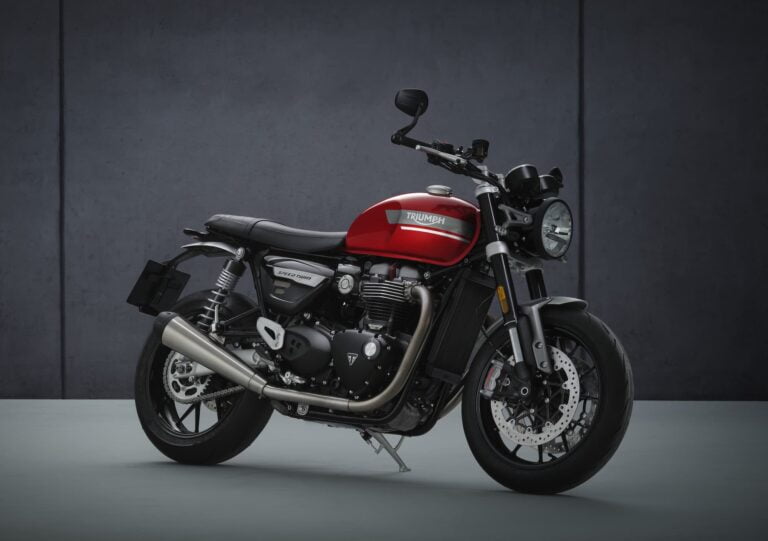
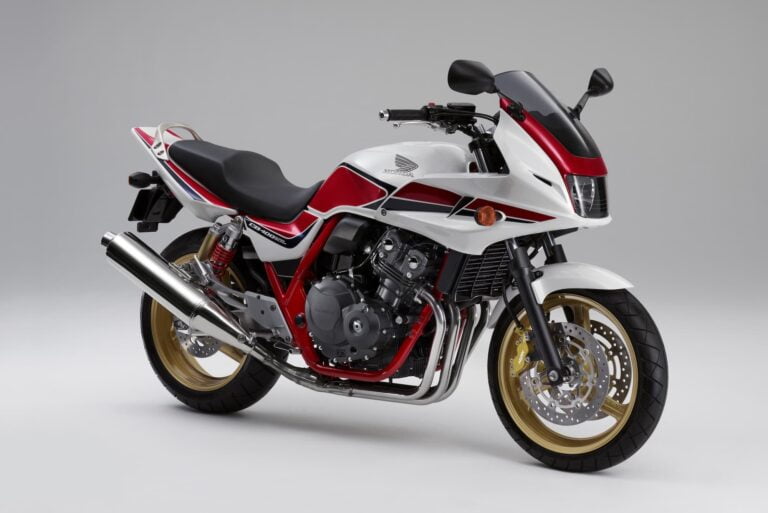
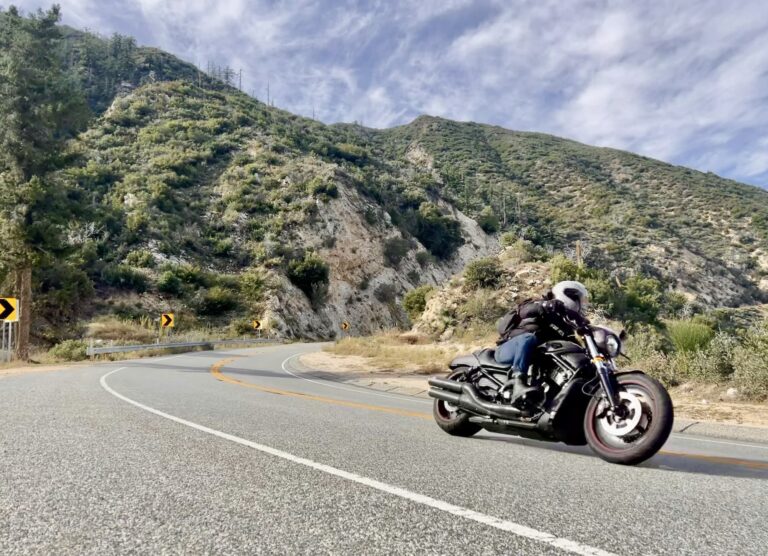
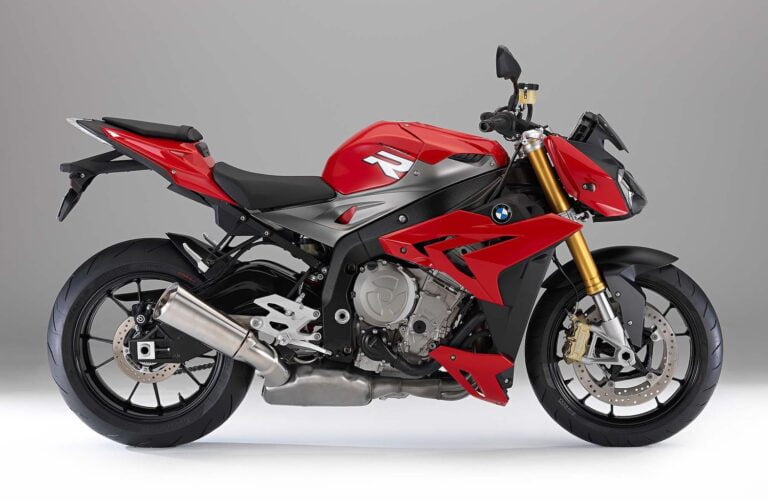
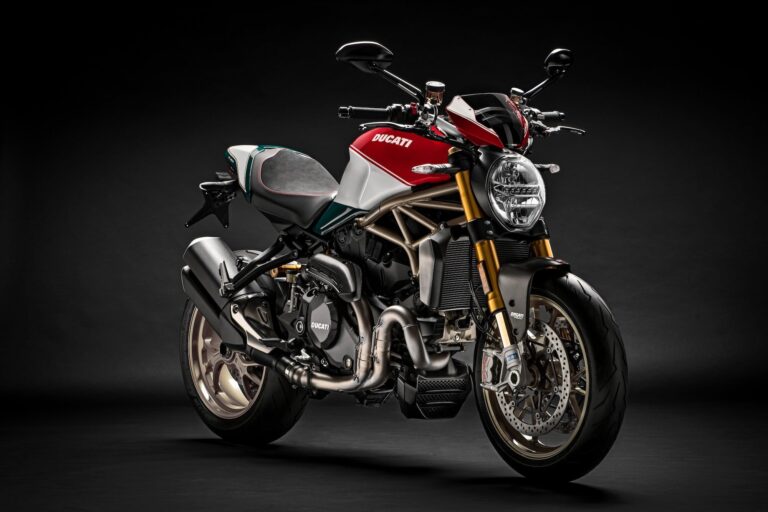
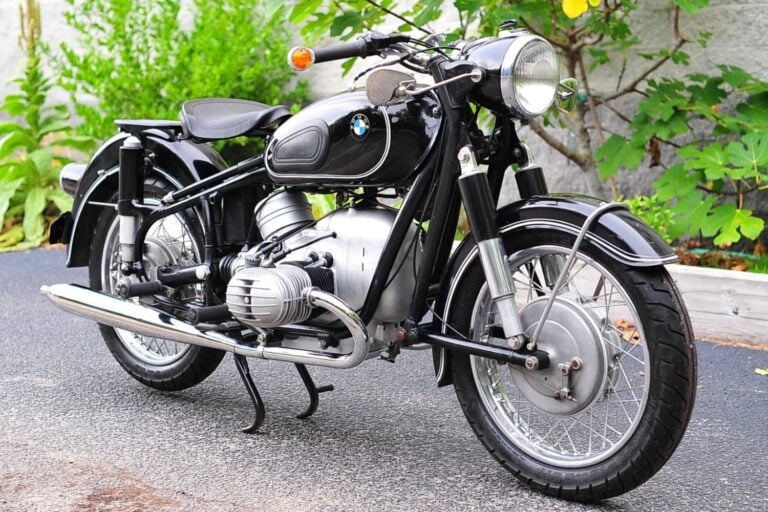
I have a 2017 CB1100EX and absolutely love it. I’ve had over 50 motorcycles and it’s one of my favorites. Very similar to a prior bike (ZRX1200R). The historical and spec content of your article was excellent and educational. Thank you!
You’re welcome. Thanks for your kind comment! I’m intrigued that it’s similar to the ZRX1200R, as it’s not a comparison most people make, even though the shop owner made the same comparison… but of course, they’re both good-looking retro standards, so why not.
I’m in the process of buying a 2010 model and I can’t wait to take it for a spin. Just read your article and it’s been a great read, thank you for posting. It’s a bike I’ve had my eye on for a while and when this low kilometre model came up, I couldn’t resist. Happy motoring 👍
I have a cb1100f, 1983 model. It has an 11,500 redline, and I love it. It’s a one year only bike and looks like it’s going 100 mph sitting still. Please would you do a story about it please ?
Hi Tom, with pleasure, especially if you help out with pics as it’s a bit hard to find those. Send them through to [email protected].
I owned a cb1100f also. 1983 had it for a number of years. Great bike. Sounded sweet with original 4 pipe exhaust. I put a hanigan fairing on it matching the red and white colours of the bike. It got looks everywhere I went.
Your machine is arguably superior to the new one, in many ways! From almost 40 years ago! Not exactly a big leap forward.
The impression I and many others had upon viewing the first generation of the new bike was disappointment with it’s overall quality – it gave the vibe that it was built to price point. Uncharacteristic for Honda.
Great article, I really enjoyed reading it.
The bike reminds me of my old CB900F I had in the late 80s and early 90s, I was considering getting the CB1100 but I’m going to have to go with the much lighter Kawasaki Z900rs alternative.
Thanks for the beautifully written article and the appreciation of a decidedly unappreciated machine…
https://i.vgy.me/FAAffG.jpg
Thanks for sharing a pic of your ride!
Loved your article. The CB1100 is my dream bike. I don’t know why it wasn’t more popular! Here’s my ’14, I’ve had it since it was new. It’s mostly the way I want it now but I have few more mods to go🤣
https://i.vgy.me/a1ahfi.jpg
I think it is not that popular because it is not really a ‘big bike’. It’s not for tall people like me (187 cm). And a lot of guys in West Europe are even taller.
That’s true. You’re from one of the few parts of the world where I (at 182 cm) feel a bit below average height!
Hi Dana. Excellent article! I’ve owned a ’79 CB750F, a 2000 CB750Y Nighthawk, and was almost the owner of a 2014 CB1100DLX in 2019. It had less than 5,000 miles on it. I was the second owner of the ’79, the first owner of the 2000, and would’ve been the second owner of the 2014. I did all my own maintenance on the first two bikes. I was able to consistently get close to 60mpg with the 2000 by using a K&N filter (just the filter, no K&N intake system). The owner of the 2014 agreed on a price, and we were going to pick it up a few days later. It was amazing in every aspect! He backed out of the deal, feeling extremely and honestly remorseful, because he just couldn’t part with it. He actually owned several motorcycles, and every one of them was immaculate. I would’ve loved to have that 2014 model for sure! I look every now and then, but I haven’t seen any that even come close. I preferred the taller seat height on those three bikes, rather than the lower “cruiser” style – just my preference.
Thanks again for the article. It brought back a ton of great memories from those three bikes.
Take care!
Dan…
Thanks! And lucky you for finding one of those recent-ish CB750 Nighthawks. Unfortunately, word got out that they’re cool, and they’re pretty hard to find!
I blame the CB1100s demise on the dealerships. I tried to buy one but the only dealer that would take my low mileage all original, perfect running 1978 Honda CB400 Hawk was a Harley-Davidson dealer. I’m sure glad they had at the time the XL1200CX Roadster, which kind of a cafe racer Sportster in it’s original guise. I’ve owned all kinds of bikes, mostly old Triumphs for over 30 years. Then 2 new Triumph triples. A Sportster, a Superglide, a Ducati Supersport, then came za 2001 Honda CBR929RR along with 2 Honda 919s. The 2007 Honda 919 was sold when I had my bout with cancer. I got back into riding with the aforementioned Honda Hawk, but wanted something brand new. Would have bought the Honda CB1100 but both Honda dealers wouldn’t take my trade in, so Harley-Davidson got my business, I guess that’s why they survived over 119 years.
Yeah some dealers have no vision. A 1978 CB400? Awesome! Also, I’d love to hear how you made the transition to Harley-Davidson other than “they took my trade in” because obviously you love the bike!
I have a simple design question about the CB1100:
I would assume the bike has its parts balanced for equilibrium according to the weight; the engine centered in the frame, the tank also, and so on. So the bike does not lean to the left or right.
So do the Honda designers take the exaust into account while ‘balancing’ the elements on the bike?
And, if so, did they recalculate and reposition the weight for the dual exhaust version?
I think I can answer your question, at least partly. If you look down at the pillion area of the bike, you can see that the shocks are mounted asymmetrically to accommodate the one-sided muffler. As for riding, I’ve never had such a well-balanced bike. Then again, I barely care if one saddle bag is loaded and the other is empty, so I might not be the best authority on the subject!
Hi, this is by far the best review of the Honda I’ve read. It really reinforced my own reasons for buying such a lovely motorcycle. It’s an honest, balanced and informative review and makes me feel, I’ve almost bought a bit of history. Looking forward to reading more on the site
Thanks again Dave Perkins
You do have a piece of history! Thanks for your kind words Dave.
I’m surprised you failed to mention that these bikes also have features like EFI, and hydraulic clutch. I currently own a 2014 CB1100 DLX. My own research shows Honda only released about 300 of these in the USA, which explains why I had such a hard time finding one myself. I also own a couple early CB750 motorcycles (both are 1971 K1 models). I fell in love with the CB1100 when first introduced and was hooked for sure when I finally got to test ride a DLX model at one of the Americade rallies in Lake George, NY. I began to causally search for one to buy shortly after that. It took a few years, but I finally found a lightly used example in AZ (less than 4K miles) and had it shipped to NH.
I’ve always felt that the CB1100 might be the natural evolution of the original CB750, had Honda kept producing the UJM in its basic form. The addition of EFI cannot be praised enough; it does away with carburation and makes cold starts a breeze. The CB1100 is also the first bike I’ve owned with ABS braking and I love it! While the CB1100 engine lacks some of the snarl of my early CB750’s, I don’t view that as a bad thing. The 4-into-2 exhaust does have a great note all its own, and I’m not a fan of noisy bikes anyway. The engine performance is more than enough to induce 2nd gear wheelies (if not paying attention) and is probably beyond my pedestrian riding skills. A great bike all around and I’m still happy I was able to snag one of these!
Thanks my friend, I had pointed out that they’re fuel injected, but the note on the hydraulic clutch is an interesting one. Glad you’re enjoying it. I didn’t find one near me, and recently picked up a Honda 919, which scratches a similar itch (though it’s not as pretty by a long shot).
The CB1100 is a good and reliable motorcycle. Ride a 2013 for 9 years now over 72.000km. Did some travelling around with it on tours in Europe leading me to the north of Norway and Scandinavia, the Baltikum, the UK and Irland. I enjoy riding around with it also I’m not a small and mounted a windshield and saddlebags. Plan to keep my CB for a long time. When you get used to it, it’s not heavy and by no means slow, if you pull the throttle. A nice commuter for everything except motocross and racetracks. I don’t have interest in both.
Own two other retro bikes, an Enfield Chrome Classic 500 and a Kawasaki W800, which are also enjoyable and lovely motorbikes. I like to ride different motor concepts and aircooled engines.
Great article Dana, thank you for writing about our beloved CB1100……I have a 2014 Deluxe with a full Whitehouse K 10 kit from Samurider.com…….love riding it! I will emai you some pics of my bikes.
The best review I’ve read about my beloved CB1100. In my opinion, the first model is superior in aesthetic terms. The tank design of the initial version is simply sublime. Congratulations on the article.
My first bike was a 1989 CB750C, then I had a 1993 Nighthawk 750. Now I have an all-black 2014 CB1100 purchased brand-new out of the crate in 2018. Three awesome motorcycles! I think I’ll have the CB1100 for a very long time, and might add a Goldwing or a Heritage Softail Classic in a few years.
The CB1100 feels like an extension of my brain and appendages. I think and it responds. Turning, braking, and acceleration all happen intuitively. If I want to maximize mileage, I upshift at 2K and get 53 MPG. If I’m out to have fun for the afternoon, I fill up and GO!
The only things I’ve had to add for comfort is a gel seat pad and grip puppies. I’m thinking about getting a windshield and highway pegs though.
Hi Dana,
I recently found the bike I’ve admired from a distance for years and now have the privilege of owning a 2014 EX. It was registered new in NZ in 2016 had only 22000kms on the clock and in great condition.
I didn’t think I would part with my Royal Enfield Interceptor 650 but I was offered a great deal on it from the local Honda dealer. There level of customer service by far is streets ahead of the Enfield dealer and was just extra icing on the cake. I know this is a special bike and it will never be sold, passing it to my eldest boy when I get too long in the tooth. Being 61 now this bike hits every nail on the head.
In 1981 I had an XV1000. It was a bike that had a feeling I never thought I would find again until I rode the CB1100. It met the brief and surpasses the XV in every way.
Thanks for the article, I will need to book mark this one.
Phil NZ
Wow, that’s amazing! It’s really special when you find a bike that captures the feeling of an old one and even exceeds it. Glad you found one. Great riding country! My most recent visit showed me remote roads that were often too twisty to even do the speed limit on (in a car). I’ve got to return on two wheels.